-
Shop owner in Hebron got both his front-windows smashed by celebrating settlers.
27th November 2016 | International Solidarity Movement, Hebron/al-Khalil team | occupied Palestine This week-end in al-Khalil brought thousands of extremist Jews and settlers from all over Israel and abroad to celebrate the week’s Torah study on Chayei Sara (Live of Sarah), where Abraham purchases the cave of Machpelah (of which they think is in al-Khalil) […]
-
Not business as usual: colonial settlers in al-Khalil for Jewish festival
27th November 2016 | International Solidarity Movement, al-Khalil team | Hebron, occupied Palestine The Jewish holiday/celebration of Chayei Sarah and the reading of the Torah regarding Sarah took place in occupied al-Khalil (Hebron) on 25th and 26th November 2016. Beginning of Friday hundreds of Jews from illegal colonial settlements within the West Bank as well […]
-
Israeli forces cause fires at Ni’lin weekly protest
25th November 2016 | International Solidarity Movement, Huwarra team | Ni’lin, occupied Palestine The non-violent demonstrations against the illegal occupation of Palestine and the Apartheid Wall in in the West Bank village of Ni’lin have been going on weekly since 2008, as an attempt to get back the land and the fields, that was stolen […]
Action Alert An Nabi Saleh Apartheid Wall Arrests BDS Bethlehem Bil'in Cast Lead Demonstration Denial of Entry Ethnic Cleansing Farmers Gaza Global Actions Hebron House Demolition International law Israeli Army Jerusalem Live Ammunition Nablus Ni'lin Prisoner Ramallah Rubber-coated steel bullets Settlement Settlers Settler violence Tear-Gas Canister Video



